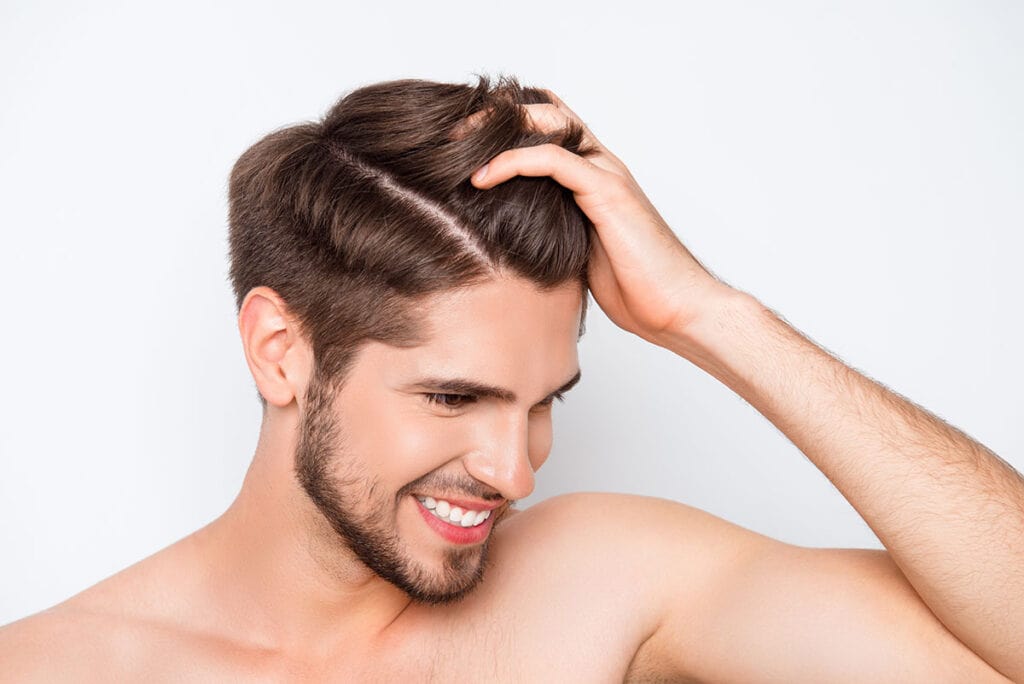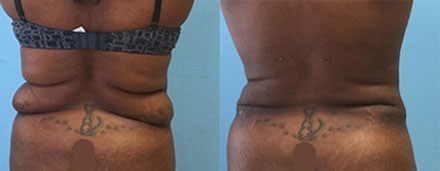PRP for hair restoration is a simple, non-surgical procedure that regrows your hair using your body’s own organic properties. When you think of the outward signs of aging, hair loss is right up there with wrinkles and fine lines. Hair loss can affect any person at any age, oftentimes making them appear older than they actually are – or older than they feel on the inside. While other hair restoration products and treatments promise thicker, denser hair, they usually underdeliver or come with a list of side effects. Because PRP uses your body’s own restorative properties, the risk of side effects is significantly minimized, leaving you with only a fuller head of hair.
If you are interested in learning how cells from your body can restore balding or thinning areas, please schedule a consultation with Dr. Saira Saini. During this one-on-one, she will examine your hair loss and determine if PRP is right for you. If you would like to speak with us directly, call our Fayetteville offices at (910) 323-1234.
Is Hair Loss Really That Common?
Believe it or not, you will probably experience some degree of hair loss during your life. After all, 80% of men and 50% of women experience hair loss.[1] There are many different causes of hair loss, but the most common one is androgenetic alopecia. This inherited condition occurs when hair follicles have been weathered down by androgenetic hormones over the years. Androgenetic hormones include testosterone and many of its derivatives. While men typically have higher amounts of testosterone, women also rely on this hormone to balance their estrogen levels. When a man is in his early to mid-twenties, his testosterone levels spike and then plateau until his 40s and 50s. That’s why some men see their hair start to gradually thin earlier than most women.
On the other hand, most women see their hair start to thin or bald later in life – during menopause. During this time, women’s hormones are unbalanced, resulting in higher androgenetic levels than normal. This hormonal spike denatures their hair’s length, color, and thickness. For women, this process typically starts around the crown of their heads. For men, this process usually begins with a receding hairline.
What Is PRP?
In the past, PRP has been used to regenerate tissue during surgery and to help reverse signs of aging in your complexion.[2] Only recently have we discovered that it also can restore damaged or atrophied hair follicles. Right now, restorative molecules like platelets, white blood cells, and nutrient-rich plasma are flowing through your blood to repair and replace damaged cells and tissues. The other half of your blood is full of oxygenated blood cells.
When working with PRP, we are interested in extracting the plasma, white blood cells, and platelets. Think of plasma as the vessel that carries properties like proteins, hormones, glucose, restorative ions, and gasses to different parts of the body. Platelets and white blood cells, on the other hand, work in concert to incite tissue growth, cell proliferation, and restoration at the molecular level. When the brain sends these properties to a wound or damaged cells, cells’ functions are revitalized. So, could these properties heal atrophied hair follicles?
How We Extract PRP
To begin a PRP session, we start by taking a blood sample. This small sample has more than enough restorative properties to begin reversing your hair loss. We then run this sample through a centrifuge. At high velocities, blood cells divide based on their densities. Once it’s done spinning, the sample of blood will be split into two layers. The denser red blood cells settle at the bottom while the top consists of plasma, platelets, and white blood cells. This top layer is called the “buffy coat” layer. We then remove the top layer and formulate it into a serum. Now, this PRP serum is ready to be placed into your balding or thinning areas.
Benefits
When deciding between hair loss treatments, your options might feel limited. From store-bought topicals to long extensive procedures, hair restoration treatments come with varying levels of commitment. While some of these options provide lasting results, they do so at the risk of adverse effects. When deciding which hair restoration procedure is best for you, consider the benefits that come along with a fuller head of hair. For PRP, those benefits include:
No Scarring
Other hair restoration procedures like follicular unit transplantation (FUT) involve long incisions and noticeable scarring. In a FUT procedure, the doctor first removes a slim strip of skin from the backside of your head. They extract the healthy follicles from this strip and suture the incision closed. While FUT has been shown to provide genuine results, it does so at the risk of noticeable scarring. After you’ve fully healed from a FUT session, a long, linear scar can be seen under short hairstyles. PRP, rather, doesn’t leave behind any scarring – only real, natural hair.
Natural Restoration
Alongside extensive surgical procedures, other hair restoration procedures include at-home solutions that may introduce your body to toxic chemicals. Many of these topicals and OTC hair loss remedies provide some results, they can also cause potential birth defects in pregnant women and prolonged impotence in men.[3]
Organic Results
Lastly, other ways to disguise hair loss include wigs, toupees, and combovers. All of these might work for a season but they often don’t provide lasting, organic results. But because PRP restores hair follicles using your own restorative properties, the results are uniquely yours! With PRP, it’s your natural hair that becomes coarser, longer, and fuller. To see these results for yourself, schedule a personal consultation with us today!
The Pull Test
For some, you know you’re losing your hair. For others, you might think you are but don’t know for sure. There’s a simple test you can perform on your own to check your follicular health. It’s called the pull test and you begin by moving your fingers through your hair. Make sure to run your fingers from roots to ends. Next, count how many hairs are in between your fingers. If you have ten or more hairs in one pass, then you might be a perfect candidate for PRP hair restoration.[4] Another easy test is to look at old pictures of yourself. Does your hair look fuller or longer? If so, then you might also be an excellent candidate for PRP!
Personal Consultation
If this is your first time with us, we will begin by learning about your desired results. Dr. Saini will examine your hair and note the thinning areas. Then, she will create a personalized treatment plan to address each of your cosmetic concerns. At the end of your consultation, we will give you a list of preparatory steps to follow.
Preparation
These steps include:
- Don’t take any blood-thinning medications before your treatment. If you are prescribed a blood thinner, consult with your provider before doing so.
- Avoid nicotine and alcohol because these will disrupt your body’s ability to recover properly.
- Stay well-hydrated before and after your procedure.
Procedure
We’ll begin by taking a small sample of your blood and running it through a centrifuge. Then, we will extract the “buffy coat” layer from the sample – that’s the top layer with all the platelets, plasma, and white blood cells. After formulating it into a serum, we’ll inject it into your balding or thinning areas. Then, once we have treated each one of your trouble spots, you will be free to go back to your daily routine without any necessary recovery steps.
Other Hair Loss Treatments
Along with PRP for hair restoration, Carolina Plastic Surgery also offers NeoGraft. NeoGraft is a follicular unit extraction (FUE) procedure that removes healthy follicles directly from the sides and back of the head. Then, after they have been prepped, the healthy follicles are relocated to balding or thinning areas. Over time, these healthy follicles take over and regrow natural hair. You can see real, natural hair growth with NeoGraft without the risk of noticeable scarring. If you are interested in seeing if NeoGraft better suits you, schedule a consultation today.
How Much Does PRP Hair Restoration Cost in Fayetteville, North Carolina?
PRP costs vary depending on the extent of your treatment. We will discuss and determine the unique cost of your care during your consultation. If you would like to stay updated on the latest in the world of plastic surgery, be sure to check out Dr. Saini’s blog. If you have any questions, call us at (910) 323-1234.
References
- Piraccini BM;Alessandrini A. (2014). Androgenetic alopecia. Giornale Italiano Di Dermatologia E Venereologia : Organo Ufficiale, Societa Italiana Di Dermatologia E Sifilografia, 149(1). https://pubmed.ncbi.nlm.nih.gov/24566563/
- Roukis, T. S., Zgonis, T., & Tiernan, B. (2006). Autologous platelet-rich plasma for wound and osseous healing: a review of the literature and commercially available products. Advances in therapy, 23(2), 218–237. https://doi.org/10.1007/BF02850128
- Cervantes, J., Perper, M., Wong, L. L., Eber, A. E., Villasante Fricke, A. C., Wikramanayake, T. C., & Jimenez, J. J. (2018). Effectiveness of Platelet-Rich Plasma for Androgenetic Alopecia: A Review of the Literature. Skin appendage disorders, 4(1), 1–11. https://doi.org/10.1159/000477671
- Khatu, S. S., More, Y. E., Gokhale, N. R., Chavhan, D. C., & Bendsure, N. (2014). Platelet-rich plasma in androgenic alopecia: myth or an effective tool. Journal of cutaneous and aesthetic surgery, 7(2), 107–110. https://doi.org/10.4103/0974-2077.138352




